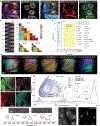Super-multiplexed vibrational probes: Being colorful makes a difference
- PMID: 35077919
- PMCID: PMC8940683
- DOI: 10.1016/j.cbpa.2021.102115
Super-multiplexed vibrational probes: Being colorful makes a difference
Abstract
Biological systems with intrinsic complexity require multiplexing techniques to comprehensively describe the phenotype, interaction, and heterogeneity. Recent years have witnessed the development of super-multiplexed vibrational microscopy, overcoming the 'color barrier' of fluorescence-based optical techniques. Here, we will review the recent progress in the design and applications of super-multiplexed vibrational probes. We hope to illustrate how rainbow-like vibrational colors can be generated from systematic studies on structure-spectroscopy relationships and how being colorful makes a difference to various biomedical applications.
Keywords: Multiplex imaging; Raman microscopy; Stimulated Raman scattering; Vibrational probes.
Copyright © 2022 Elsevier Ltd. All rights reserved.
Conflict of interest statement
Declaration of competing interest The authors declare that they have no known competing financial interests or personal relationships that could have appeared to influence the work reported in this paper.
Figures




References
-
- Krutzik PO; Nolan GP, Fluorescent cell barcoding in flow cytometry allows high-throughput drug screening and signaling profiling. Nat Methods 2006, 3 (5), 361–8. - PubMed
-
- Nitta N; Sugimura T; Isozaki A; Mikami H; Hiraki K; Sakuma S; Iino T; Arai F; Endo T; Fujiwaki Y, Intelligent image-activated cell sorting. Cell 2018, 175 (1), 266–276. e13. - PubMed
Publication types
MeSH terms
Grants and funding
LinkOut - more resources
Full Text Sources

